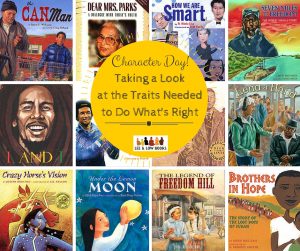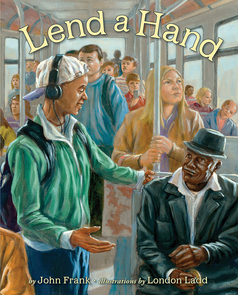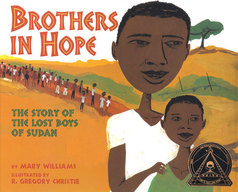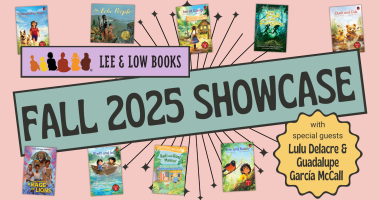 Character Day is September 18! With the start of school, many educators and staff may already be teaching character education to foster a warm, productive classroom community. For others looking to spend a moment reflecting on the concept of character, we are highlighting books for teaching about justice and the traits needed in the long struggle for it.
Character Day is September 18! With the start of school, many educators and staff may already be teaching character education to foster a warm, productive classroom community. For others looking to spend a moment reflecting on the concept of character, we are highlighting books for teaching about justice and the traits needed in the long struggle for it.
We are highlighting books that will spark conversations centered on leadership, love, kindness, social responsibility, perseverance, fairness, and teamwork.
GRADES K–2
 Lend a Hand: Poems About Giving
Lend a Hand: Poems About Giving
A collection of original poems centered on giving and spontaneous acts of kindness, which also incorporate larger themes of community, intergenerational relationships, young mentors, and care for the environment.
To earn money, a young boy decides to collect and redeem empty soft drink cans, but ends up giving away his money to help a local homeless man.
A fictional story set during the California Gold Rush, in which a girl teams up with her best friend in search of gold to buy her mother’s freedom from a slave catcher.
Rosalinda sees a man leave with a large sack full of fruit from her beloved lemon tree. After consulting with family and neighbors about how to save her sick tree, Rosalinda sets out in search of La Anciana, the Old One, the only person who might have a solution to Rosalinda’s predicament.
GRADES 3–5
 Brothers in Hope: The Story of the Lost Boys of Sudan
Brothers in Hope: The Story of the Lost Boys of Sudan
Based on heartbreaking yet inspirational true events in the lives of the Lost Boys of Sudan, Brothers in Hope is a story of remarkable and enduring courage, and an amazing testament to the unyielding power of the human spirit.
The true story of the great Sioux warrior who, as a young boy, defies tradition and seeks a vision on his own in hopes of saving his people.
 Dear Mrs. Parks: A Dialogue with Today’s Youth
Dear Mrs. Parks: A Dialogue with Today’s Youth
Mrs. Parks received 500 to 1,000 letters a month from children throughout the United States and the world. Dear Mrs. Parks grew out of Rosa Parks’ desire to share her legacy with all “her children,” and perpetuate a dialogue that will be recorded for generations to come.
 Seven Miles to Freedom: The Robert Smalls Story
Seven Miles to Freedom: The Robert Smalls Story
The true story of Robert Smalls, a slave steamboat wheelman who commandeered a Confederate ship during the Civil War and escaped with his family and crew to freedom.
 Passage to Freedom: The Sugihara Story
Passage to Freedom: The Sugihara Story
The true story of Chiune Sugihara, the “Japanese Schindler,” who, with his family’s encouragement, saved thousands of Jews in Lithuania during World War II.
GRADES 6–8
 Game, Set, Match, Champion Arthur Ashe
Game, Set, Match, Champion Arthur Ashe
A picture book biography of tennis player Arthur Ashe, who began his career playing tennis as a child on the segregated courts as a child in Virginia and went on to become the top tennis player in the world.
Musician Tito Puente. Ballerina Maria Tallchief. Explorer Matthew Henson. Congresswoman Patsy Mink. These are some of the people profiled in this book. They are well known for different reasons, but they also have something in common. They were all smart! When readers see how the people in this book used their smarts, they will learn about themselves too, and their own unique ways of being smart.
A biography in verse of reggae legend Bob Marley, exploring the influences that shaped his life and music on his journey from rural Jamaican childhood to international superstardom.
Discussion Questions During and After Reading:
- What kind of person is the main character or historic figure? How would you describe him or her? What does he or she value? How does he or she act in the face of adversity or inequity?
- What motivates the main character or historic figure to fight injustice or inequity? What obstacles does he or she encounter?
- What injustice does the main character or historic figure see or experience? How does he or she solve (or work towards solving) it?
- What risks does the main character or historic figure take for something he or she believes is right and worthwhile?
- The main character or historic figure strives to make a difference. How do you think young people can make a difference? How would you go about addressing a wrong?
- What did you learn from this story? How might you turn what you learned into action?
- Even if this story is set in the past, how might this story still be timely? How does it relate to conditions in our own community or the news today?
Activities:
- Read two of the books suggested above. What are some characteristics the two figures or characters have in common? How do their traits help them succeed?
- Pair these books with news examples of young people helping others or speaking out about injustice. How do these examples show someone is never to young to make a difference and take on injustice?
- Explain that people are often honored on postage stamps. Have students design a stamp to honor the figure or character in the book. Ask students to write a paragraph describing and explaining their designs.
- Have students compose and present a speech that will communicate the thoughts and feelings of the main character or historic figure to an audience of young people.
- Imagine that you are this historic figure or main character and write a diary account of daily thoughts and activities. Be sure to capture his or her feelings about the people he or she meets and what happens to him or her.
For further reading on character, character education, and social-emotional learning:
- How to Choose Books for Core Value Study
- How to Teach Core Values to Kids Meaningfully
- 7 Core Values to Celebrate Black History Month
- Reading Biographies to Reflect on Core Principles and Create Belonging
- The Right Read Aloud for the Classroom Community You Want This Year
Jill Eisenberg, our Senior Literacy Specialist, began her career teaching English as a Foreign Language to second through sixth graders in Yilan, Taiwan as a Fulbright Fellow. She went on to become a literacy teacher for third grade in San Jose, CA as a Teach for America corps member. In her column at The Open Book, she offers teaching and literacy tips for educators.















